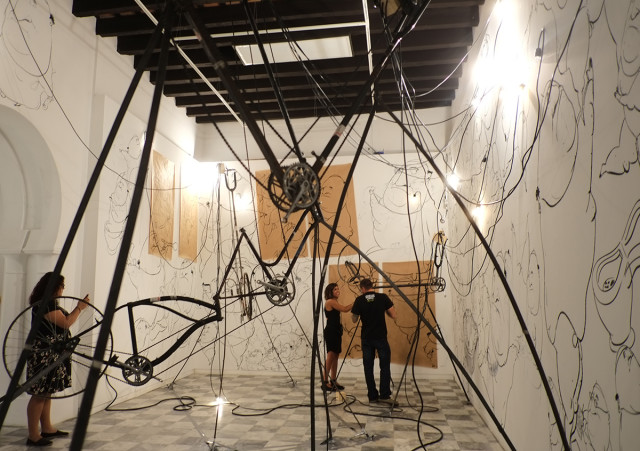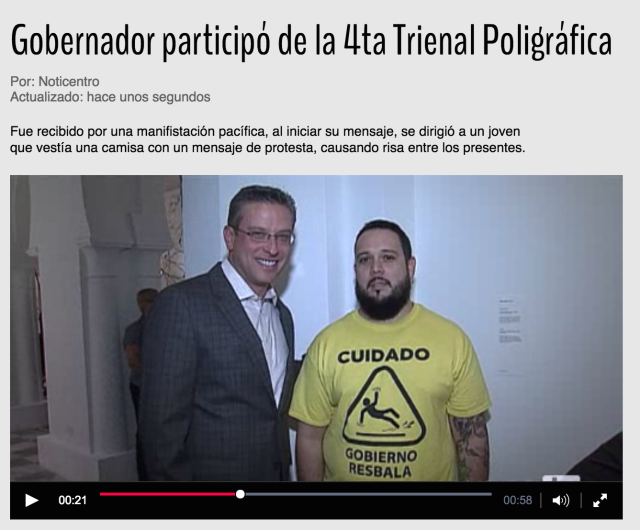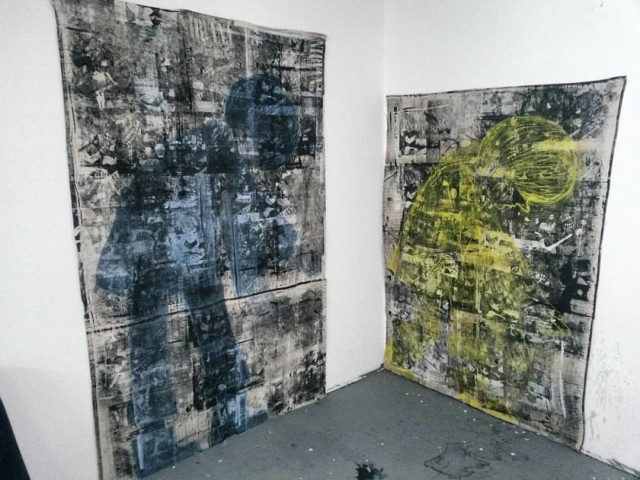
Workers demonstration in front of Arsenal de la Marina during the opening for the 4th Poly/Graphic Triennial: Latin America and The Caribbean
What it is: The 4th San Juan Poly/Graphic Triennial: Latin America and the Caribbean focuses on contemporary and experimental practices in printmaking. For this edition the curatorial team is comprised of chief curator Gerardo Mosquera (Cuba) and co-curators Vanessa Hernández Gracia (Puerto Rico) and Alexia Tala (Chile). Over 40 artists were invited to participate including art luminaries like Alfredo Jaar, Amalia Pica and Luis Camnitzer.

Installation by Ricardo Lanzarini at 4th Poly/Graphic Triennial: Latin America and The Caribbean
Dianne: On a rainy Saturday night we attended the official opening for the Triennial at Arsenal de la Marina Española, a colonial era military fortress that’s one of the multiple venues designated for the event. Outside, PROSOL workers’ union was protesting Governor Alejandro García Padilla’s anti-labor and austerity agenda. They weren’t boycotting the event, just trying to get their message through. Once inside, protocolar activities started an hour and a half late. They were waiting for the Governor to show up. The mayoress of San Juan Carmen Yulín Cruz, a self proclaimed arts supporter, never did.
Pedro: Late and not even a press preview. We shouldn’t really call it opening night. It was a political rally rather than a celebration of an important cultural event that’s been evolving for the past 40 years. And how about those free standing signs advertising the island as tourist destination obstructing the view of some works? Perhaps the saddest thing was encountering empty rooms and only a handful of wall labels with the artist’s names describing what we were seeing. Most disappointing was the interaction between the Governor and artist Karlo Andrei Ibarra during the protocolar salute. When the Governor pointed at Ibarra’s protest piece, a bright yellow T-shirt mimicking a “slippery when wet” sign which read: “Warning: Slippery Government,” he used it to anchor a paternalistic speech about citizens who criticize the government. According to Padilla when they do this, they are bashing themselves and their country. Strangely enough Ibarra did not reply, wasting a precious opportunity.
Did you get the feeling his speech was premeditated? It served him really well to further his propagandistic views of shared responsibility during the current economic crisis.
Dianne: The Governor has been using this tactic to make the people feel as though they are responsible for the current crisis when in fact, it was created by his government, by previous administrations and by our colonial status. Later on the artist told me he wore the T-shirt in support of the workers protesting outside. While I empathize with his action, I told him that he could’ve used the spotlight to boldly point out his discontent instead of staying silent.
Pedro: His discontent and the whole country’s, I assume.
Dianne: At least new luster was brought to the endeavor by the participation of non-official entities, independent art spaces, galleries and even schools. The exhibitions organized at these venues served to expand the diversity of the Triennial that has long struggled with a lack of inclusivity.

Report from local TV station WAPA TV doesn’t identify karlo Andrei Ibarra by name, or as an artist participating in the Triennial, but as a youth wearing a protest T-shirt who happened to provoke laughter among visitors during protocolar salute.
Pedro: I give them props for it and I hope they succeed in the long run. But do you think ambition is to blame here for the apparent organizational debacle? The economic crisis? Is not like curator Gerardo Mosquera is an amateur.
Dianne: I think that the crisis has something to do with it, as does the bureaucracy at the Institute of Puerto Rican Culture. Obviously, these issues are intertwined; the Institute is the organizer of the Triennial, and provides most if not all the funding for the event. When they are underfunded, it shows. Exhibitions have been running late and lacking organization. Venues like the Museo de San Juan and Casa Blanca in San Juan and Universidad del Turabo in Gurabo are still closed to the public. Were it not for the “non-official” venues putting up high caliber exhibitions in honor of the Triennial, the entire opening weekend would have been a loss.
Pedro: Okay, so while we wait for the powers that be at the Triennial to get their act together, let’s talk about some of the parallel events and exhibits in Santurce, an emerging arts district the New York Times dubbed “Puerto Rico’s Bushwick.”

Fernando Pintado at La Productora.
Photo by collector Antonio Luis Castro Barreto.
La Productora
628 Calle Ernesto Cerra
Open through November 23
What it is: Nirvana themed show Oh Well, Whatever, Nevermind by NY based Fernando Pintado.
What’s on view: Large monotypes using canvas and brown bag accumulations as support surface. Iconography in the works include images of slouchy faceless children, flowers, scribbled text referencing Nirvana songs, dates, street lingo, names, famous punk clubs in Puerto Rico and buildings. Also in the show are 3 huge oils sticks the artist used to make the monotypes.
Dianne: First, I must admit that I am probably biased since I’m a hardcore Nirvana fan. This show seemed to me like a shrine to all things Nirvana, with references to lyrics and Kurt Cobain’s life all over a series of monotypes. During opening night Pintado placed an electric guitar and amp in front of his painting “Tourette’s”, letting the feedback sound engulf the warehouse space. “Tourette’s” is a reference to the same-named angst ridden Nirvana song. From my perspective the artist truly succeeded in providing a link between his artwork and Nirvana’s legacy.
Pedro: I had seen Pintado’s new work on his Instagram feed a while back and always wondered what he was up to since the scale of his monotypes on brown paper bags with images of these druggie versions of Precious Moments children looked borderline commercial and too teenage for my taste. However, seeing the works in person changed my perception. The small monotypes presented as wall installations alongside the large canvases do bring a level of importance to the theme and nostalgia one can feel instantly entering the space.
Pintado’s use of generic brown bags is not only a throwback to the DIY aesthetics boom from the 1990s but a direct reflection on his economic reality and the island’s economic debacle as well. I dig the raggedy, faceless boy figures. There’s something about their stretched little arms asking for a hug or emotional support that appeals to me. It’s the sadness anyone can relate to in Pintado’s work. It could also be Pintado is simply inspired by drug culture and the famous Cobain crime scene photo of the brown bag containing shotgun shells. Dianne, we are 15 years apart and for me Cobain marks the end of the Reagan era. At the same time Cobain, however rebellious, embodied a white privileged mindset. You were probably 8 when Nevermind came out so I kind of get your affection towards the subject.

“Tourette’s” by Fernando Pintado at La Productora
Dianne: I particularly enjoyed Pintado’s small monotypes, though they are somewhat “teenage” , the direct references to Cobain’s life and art really did it for me. For example, one of them reads “Boddah”, a nod to Cobain’s same-named childhood imaginary friend. It brings a sense of yearning and sentimentality to the show. I disagree that Cobain represents a “white privileged mindset”. Cobain was a feminist and had very libertarian and progressive views.

Installation view of Jaime Crespo’s exhibition at Recinto Cerra. Image credit: Manuel Mendoza Sanch
Recinto Cerra
619 Calle Cerra, Santurce
Open through November 22
What’s on view: 40 small abstract sculptures made of used soap pieces and presented on small wooden pedestals and encased in glass. Recinto Cerra’s founder, artist Jaime Crespo invited artists, curators and art historians to give him pieces of their used soap.
Dianne: Reading about this show doesn’t exactly inspire excitement. It’s a show of used soap. But, the presentation—soap stands assembled by Crespo inside glass enclosures—did a lot for this work. They took on a taxonomic museum like structure that lent an air of importance to it. Small, delicate, and precious.
Pedro: Yup. I do like these delicate soap sculptures. Some even resemble quartz stones, others look like ceramic. And the gallery smells so clean in contrast to Santurce’s dirty, stinky streets. What freaked me out was seeing a piece of soap that belonged to star curator Pablo de la Barra, to think he washed his private parts with it is kind of icky, no? [Editor’s note: This soap with hair was pretty gross.]

(L-R) Jaime Crespo’s soap sculptures representing curators Marilú Purcell (former Director of Fine Arts Program at Institute of Puerto Rican Culture) Gerardo Mosquera, Chief curator Poly/Graphic Triennial 2015 and independent curator Pablo León de la Barra
But how does a curator who doesn’t reside in the island and has limited knowledge of our politics, gets to have a soapy shrine? He wrote a chapter on Puerto Rico for Phaidon’s book Art Cities of the Future, but it’s been polemical for its historical inaccuracies and limited geographical scope of what constitutes a “Puerto Rican” art scene or market. Gerardo Mosquera, the chief curator of the Triennial, has one soapy shrine too! In which way or form has Mosquera contributed to “shaping” the Puerto Rican scene? I believe they are the only foreigners (or art workers living outside our borders) who were invited to collaborate. Crespo’s selection of these two figures seems so random when I could name you at least a dozen people living elsewhere who are influential to the scene. Why not include all these figures? People who don’t just come to the island as tourists but folks who visit often, mingle, support, connect the dots and make stuff happen—people like painter and educator José Lerma, or Rocio Aranda Alvarado, chief curator of Museo del Barrio.
Some of these choices might have to do with pre-existing connections—he may not have the needed connections to reach out to these folk. As it stands,the work focuses on the Puerto Rican scene, which feels a little opportunistic. After all, the title (Transformation of Intimacy) does suggest there’s an intrinsic knowledge of what constitutes power play and hierarchical structures within the art system. Crespo’s installation is not about real cultural value perse but adulation and egocentrism. These are not portraits, these soaps are telling viewers Crespo must have/want some sort of personal relationship with this cast of characters.
Dianne: Though I agree with you that there was probably opportunistic curating to Crespo’s selection of De la Barra and Mosquera, we are actually just guessing. We shouldn’t assign intentions to Crespo that we are not certain of. To my mind, the bigger problem with his decision to organize a show with the soaps of “highly influential” people of the art scene is that it promotes an elitist approach to art. As if the only relevant thing in art were the “procerato” (heroes and personalities).


Comments on this entry are closed.